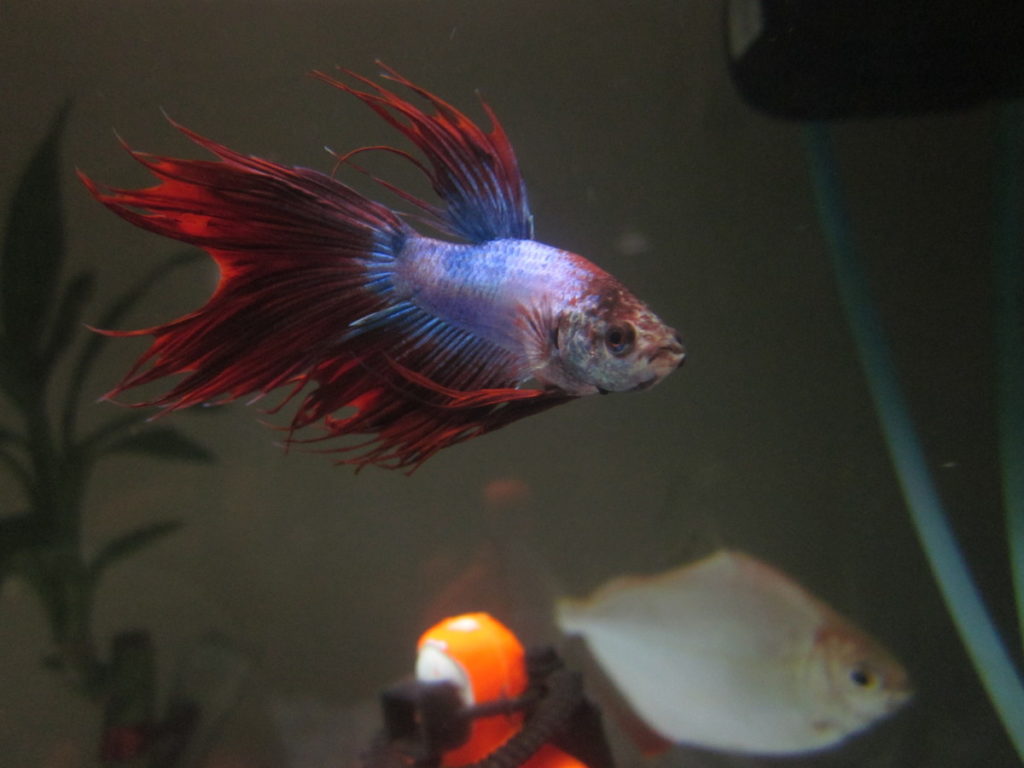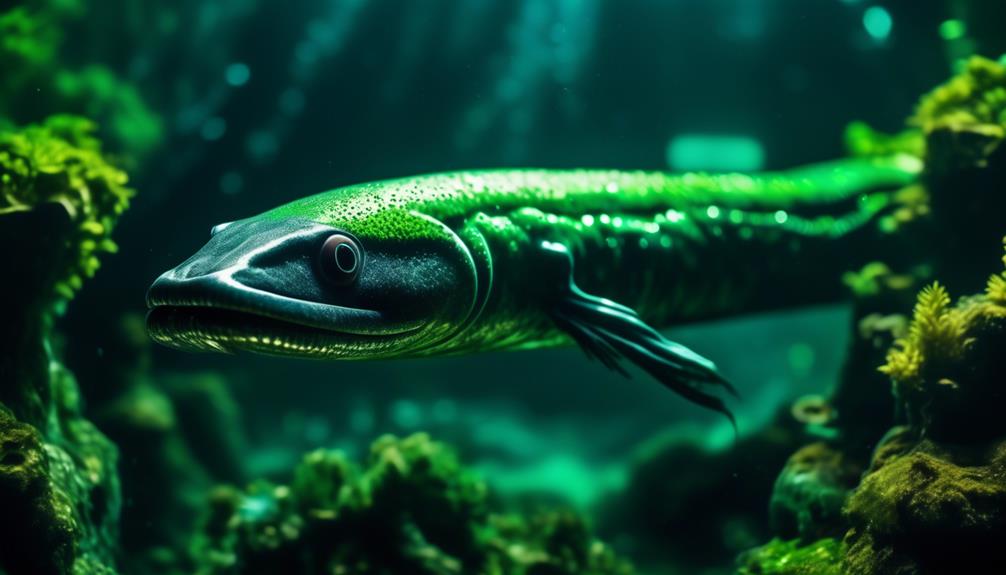
Have you ever wondered how eels manage to navigate through the darkest depths of the ocean?
Picture this: you’re diving off the coast of Australia, exploring a vibrant coral reef, when suddenly you spot a peculiar creature gliding effortlessly through the water. This mysterious eel, known as the ribbon eel, is a prime example of the fascinating world of these enigmatic creatures.
But what makes eels so unique? How do they adapt to their diverse habitats? And what secrets do they hold within their serpentine bodies?
Prepare to be captivated as we unravel the mysteries of eels, revealing their extraordinary traits and shedding light on their remarkable survival strategies.
Key Takeaways
- Eels are a diverse group of fish species found in freshwater and saltwater environments.
- Eels require large aquariums or outdoor ponds and are not recommended for beginner aquarists.
- Eels are bottom dwellers and prefer soft substrate and dimly lit aquariums with hiding places.
- Eels are opportunistic predators and have specific dietary needs, requiring a range of live and frozen foods for a balanced diet.
Eel Habitat and Size
Eels inhabit freshwater environments such as rivers, lakes, and estuaries, and can grow to over 3 feet in length. These slimy creatures are known for their long, snake-like bodies and merged fins. They prefer soft substrate like sand or smooth gravel in their habitats.
Eels are bottom dwellers and are active swimmers, requiring large open swimming spaces. They’re also nocturnal, so they enjoy dimly lit aquariums with plenty of hiding places.
When it comes to tank mates, eels can be aggressive, so careful consideration is needed. Suitable companions include loaches, plecos, black ghost knifefish, and bichirs. Eels are opportunistic predators and will eat any fish they can fit in their mouths, so it’s important to choose their tank mates wisely.
Understanding Eel Characteristics
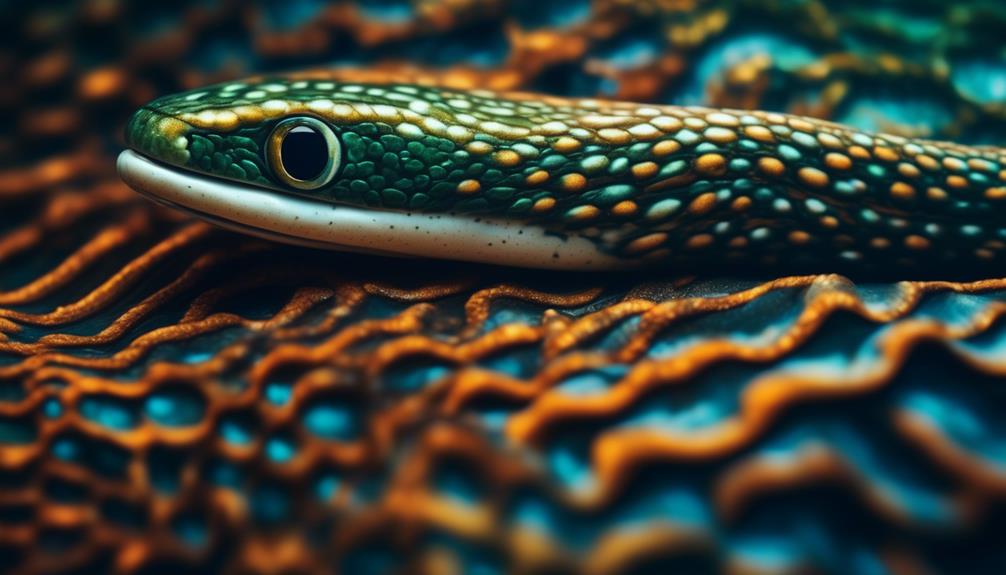
When learning about eels, it’s important to understand their unique characteristics and how they contribute to their overall care and maintenance.
Eels have long bodies, snake-like heads, and fins that merge with their tails. They’re bottom dwellers and prefer soft substrate like sand or smooth gravel.
Eels are nocturnal and enjoy dimly lit aquariums with plenty of hiding places. They’re active swimmers and require large open swimming spaces.
Eels can be aggressive, so careful consideration is needed when choosing tank mates. Suitable tank mates include loaches, plecos, black ghost knifefish, and bichirs.
Eels are opportunistic predators and will eat any fish they can fit in their mouths. They require weekly care and aren’t recommended for beginner aquarists.
Proper Care and Maintenance for Eels
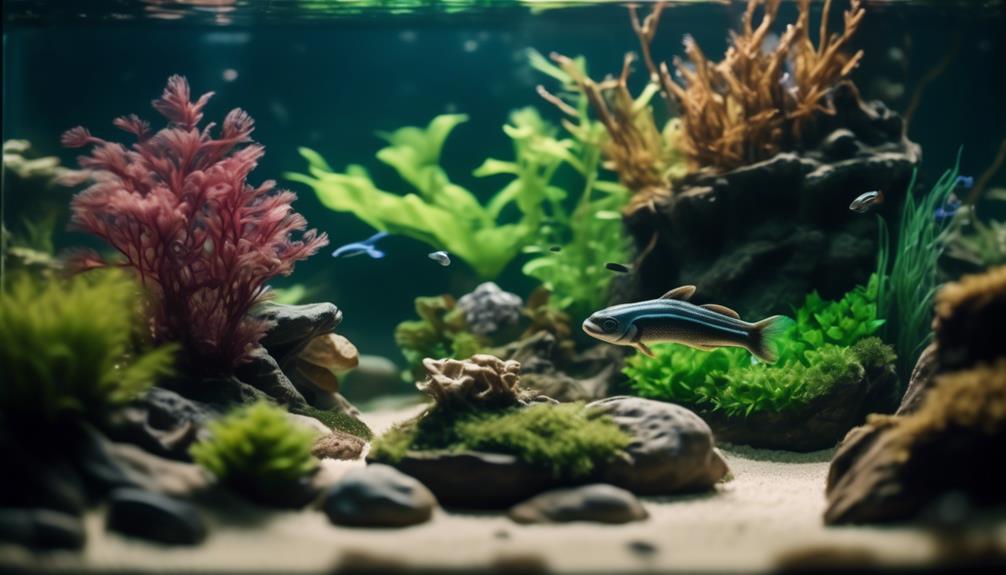
To properly care for and maintain eels, it’s essential to understand their specific needs and requirements. Here are some important tips to help you provide the best care for your eels:
- Provide a large aquarium or outdoor pond, preferably 50+ gallons, to accommodate their size.
- Use soft substrate like sand, smooth gravel, or peat to create a comfortable environment.
- Create a dimly lit aquarium with plenty of hiding places for their nocturnal nature.
- Ensure there are large open swimming spaces as eels are active swimmers.
- Research the temperament of different eel species and choose suitable tank mates.
Feeding Requirements for Eels
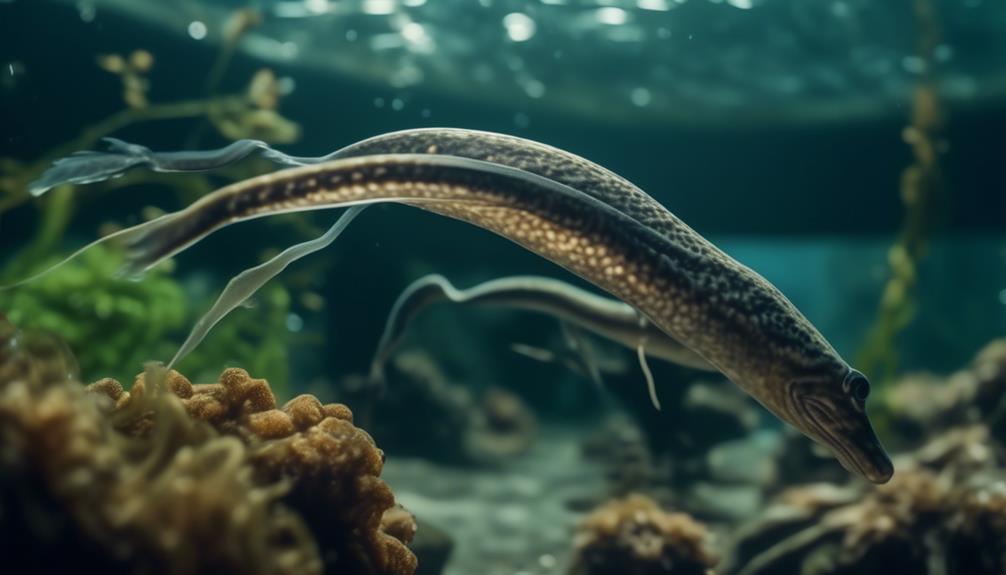
Feeding eels requires a diverse range of live and frozen foods to ensure a balanced diet. Eels are opportunistic predators and will eat any fish they can fit in their mouths. They feed on live and frozen foods such as shrimp, small crustaceans, mosquito larvae, tubifex worms, and bloodworms. It’s important to provide a variety of food options to meet their specific dietary needs.
Eels should be fed regularly, taking into account their active feeding behavior. During feeding, it’s crucial to observe them to ensure they’re eating properly. Depending on the species, eels may require specific feeding techniques or special food preparations.
Breeding and Varieties of Eels
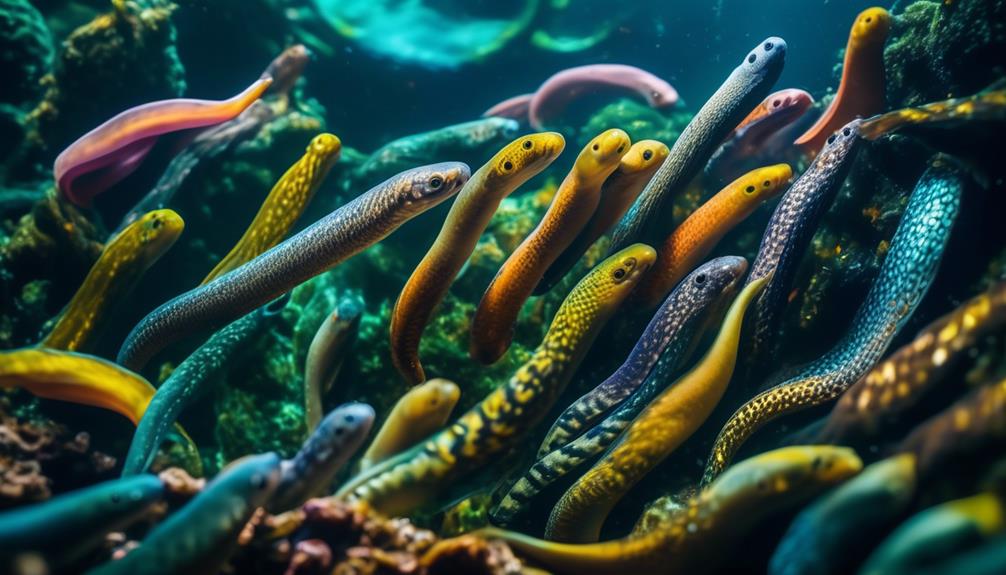
After understanding the feeding requirements for eels, let’s now explore the fascinating world of eel breeding and the different varieties available in the aquarium trade.
- Breeding eels in a home aquarium is rare, as it requires specific conditions and expertise.
- The aquarium trade offers various eel species, including the black spotted eel, electric eel, fire eel, peacock eel, tire track eel, and zig zag eel.
- It’s important to note that saltwater eels also exist, with their own care requirements.
- Saltwater eels have long, snake-like bodies, scale-less skin, and merged fins.
- Additionally, bichirs are a primitive freshwater fish species known for their long, eel-like bodies and unique dorsal finlets.
Exploring the breeding and varieties of eels can be a fascinating journey, but it’s crucial to research and provide the appropriate care for these unique aquatic creatures.
Eels in Saltwater Environments
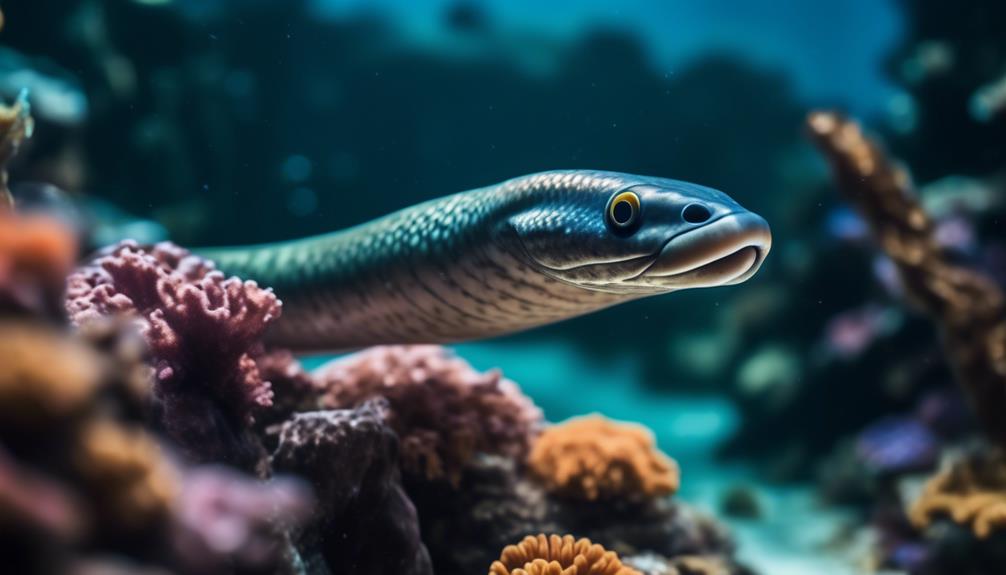
In saltwater environments, eels thrive with their long, snake-like bodies, scale-less skin, and merged fins. These adaptations allow them to navigate through the currents and depths of the ocean with ease.
Saltwater eels can be found in a variety of habitats, including coral reefs, rocky coastlines, and mangrove forests. They’re known for their ability to camouflage and hide among the crevices and structures of their surroundings.
These eels are opportunistic predators, feeding on small fish, crustaceans, and even other eels. Some popular species of saltwater eels include the moray eel and the garden eel.
Despite their intimidating appearance, these eels play a crucial role in maintaining the balance of marine ecosystems.
Bichirs: The Primitive Freshwater Fish
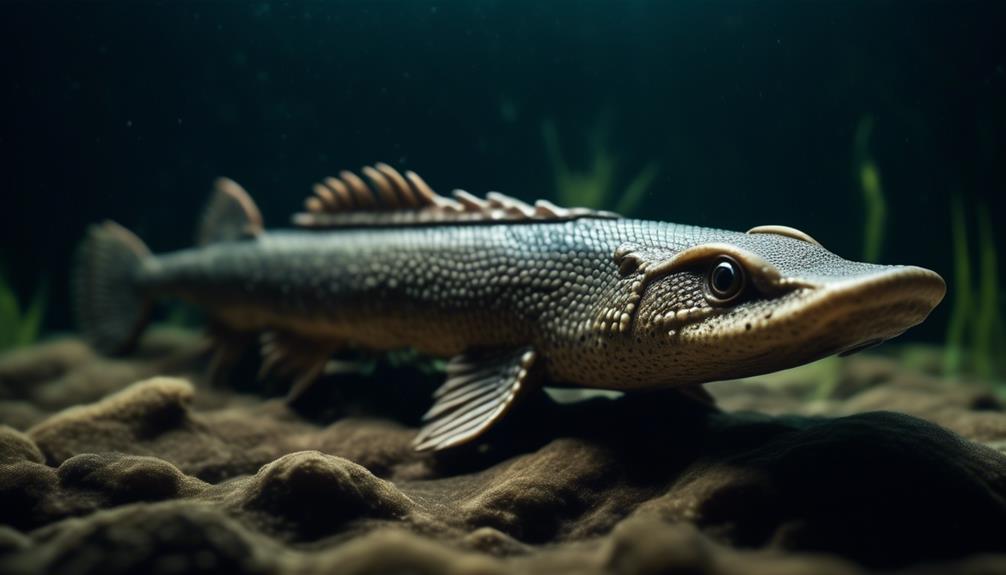
Saltwater eels may be fascinating, but now let’s dive into the world of bichirs: the primitive freshwater fish.
- Bichirs are ancient fish that have remained relatively unchanged for millions of years.
- They’ve long, slender bodies similar to eels, but with a unique feature: dorsal finlets.
Bichirs are known for their ability to breathe air using a specialized lung-like organ. They’re hardy and adaptable, able to survive in a variety of water conditions. Bichirs are carnivorous and feed on small fish, insects, and crustaceans.
If you’re looking for an interesting and unique addition to your aquarium, bichirs are definitely worth considering. With their ancient appearance and fascinating behaviors, they’re sure to captivate any fish enthusiast. Just make sure to provide them with plenty of hiding places and a suitable diet to keep them healthy and happy.
Tips for Choosing and Caring for Eels
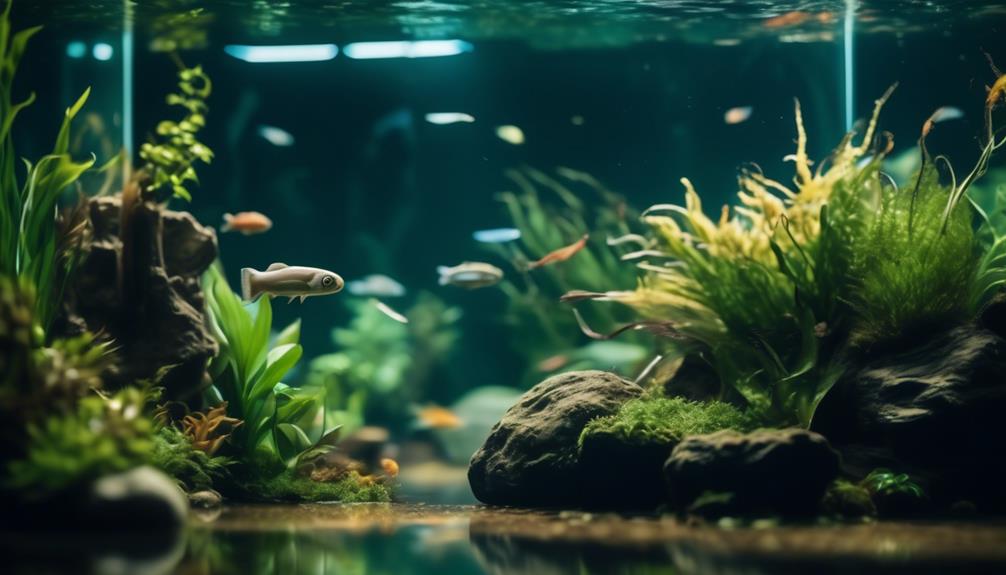
Looking to add an eel to your aquarium? Here are some tips for choosing and caring for these fascinating fish.
When selecting an eel, consider its size and temperament. Choose a species that will thrive in your tank’s conditions and get along with your other fish.
Eels require large aquariums or outdoor ponds, preferably 50+ gallons, with soft substrate and plenty of hiding places. They’re nocturnal, so provide a dimly lit environment. Eels are active swimmers, so ensure there’s enough open swimming space.
Feed them a variety of live and frozen foods, taking their dietary needs into account. Monitor their feeding habits to make sure they’re eating properly.
Eels aren’t recommended for beginner aquarists due to their specific care requirements, but with proper research and attention, they can be a captivating addition to your aquatic collection.
Frequently Asked Questions
Can Eels Be Kept in a Small Aquarium or Do They Require a Large Tank?
Eels can’t be kept in a small aquarium; they require a large tank. They grow over 3 feet in length and need plenty of space to swim. Consider a tank size of 50+ gallons.
How Often Should Eels Be Fed and What Should Their Diet Consist Of?
Eels should be fed regularly, taking into account their specific dietary needs. Their diet should consist of live and frozen foods like shrimp, small crustaceans, mosquito larvae, tubifex worms, and bloodworms. Observe them during feeding to ensure they eat properly.
Are Eels Compatible With Other Fish Species, or Do They Need to Be Kept Alone?
Eels can be compatible with certain fish species like loaches, plecos, black ghost knifefish, and bichirs. However, they can also be aggressive, so careful consideration is needed when choosing tank mates.
Do Eels Need a Specific Type of Lighting in Their Aquarium?
Eels prefer dimly lit aquariums with plenty of hiding places. They are nocturnal and enjoy a calm environment. It is important to provide the right type of lighting for their needs.
Can Eels Be Trained to Eat Prepared or Commercial Fish Food Instead of Live or Frozen Prey?
No, eels cannot be trained to eat prepared or commercial fish food instead of live or frozen prey. They are opportunistic predators and require a diet of live and frozen foods to thrive.
What Makes Saltwater Eels Aggressive?
The behavior of mysterious saltwater eels unveiled seems to be related to mating and territorial instincts. They become aggressive when protecting their space or competing for a mate. Some eels also exhibit territorial behavior, especially during the mating season. Additionally, changes in water temperature or environment can also trigger aggressive behavior.
Conclusion
In conclusion, diving into the fascinating world of eels is a thrilling adventure. From their mesmerizing swimming patterns to their aggressive nature, eels captivate our imagination. Understanding their habitat, characteristics, and care requirements is essential for their well-being in an aquarium or outdoor pond.
Feeding them properly and creating the perfect environment with dim lighting and hiding spots are crucial. Breeding eels brings both challenges and rewards. Whether in freshwater or saltwater environments, eels are diverse and beautiful creatures that never fail to amaze us.

